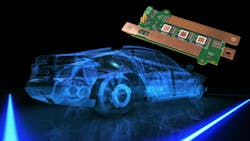Integrating Current Sensors into SiC Power Modules for EVs
Silicon Austria Labs (SAL), a power semiconductor research lab, completed a proof of concept for integrating current sensors into a power module intended for use in electric-vehicle traction inverters and DC-DC converters.
The lab said this technology enables higher efficiency while reducing the size and weight of traction inverters and other ultra-high-current power electronics based on next-generation silicon-carbide (SiC) power devices. At the heart of the new power module is a contactless, coreless, magnetic current sensor designed by Asahi Kasei Microdevices. The chip is a potential replacement for the magnetic core-based current sensors deployed in many EVs today.
The companies showcased the new power module with integrated current sensing at PCIM 2025.
Precision Current Sensing in the Traction Inverter
The traction inverter is one of the EV’s core components, acting as the bridge between the high-voltage battery pack and the powertrain. It plays a critical role in converting DC from the battery into the three-phase AC used to power the motor.
To ensure smooth and efficient control across varying driving conditions—such as braking, accelerating, and driving at low and high speeds—precise current sensing over a wide dynamic range is essential. But the current sensors commonly used in EVs today tend to be large and heavy or require physical contact.
Today, thin strips of laminated metal called busbars are used to distribute vast amounts of current from the battery pack to the traction inverter and all other power electronics under the EV’s hood. To measure the current running through them, metal loops slide over the busbar to act as magnetic cores, and the current creates a magnetic field in the core. In general, contactless Hall-based current sensors are placed in a small slot in the core to measure the magnetic field, which is proportional to the current racing through the busbar.
Going Coreless to Minimize Space and Weight
SAL said it used AKM’s latest Hall-based coreless current sensor to significantly reduce space and weight. The current sensor is capable of handling very large currents—up to several thousand amps or kiloamps—without requiring a magnetic core. It also comes with high resolution (approximately 1 ARMS) even at up to several hundred amps of current.
In addition, the device measures small currents accurately, enabling high efficiency even at partial loads. With its wide bandwidth and high accuracy, the new current sensor IC—the EZ232L—can be placed directly under the busbars running in and out of the power module.
This integration also makes it possible to use a standard printed circuit board (PCB) for the power module. In many cases, SiC MOSFETs in EV power modules are mounted on ceramic substrates using direct copper bonding (DCB).
These ceramic substrates have been a hit thanks to their electrical isolation, high thermal conductivity, and robust power-handling capabilities. But they come at a higher cost. Instead of using a ceramic substrate for the entire module, SAL said it packaged each of the SiC power MOSFETs on a ceramic substrate using DCB and then attached the three ceramic-packaged power devices to a standard PCB. This approach could help reduce costs, according to SAL.
“The designed power module offers an all-in-one solution, integrating the latest direct-copper-bonded power semiconductors along with gate-driving circuits and current-sensing capabilities. Using a standard PCB and off-the-shelf components, the module provides both flexibility and cost advantages for small-to-medium production volumes,” said Thomas Langbauer, one of the team leads in SAL’s power electronics division.
The Impact of SiC
SiC is playing an integral role in EV traction inverters. Power MOSFETs based on SiC can operate at faster switching frequencies than conventional IGBTs, rapidly switching on and off to produce a smoother AC signal, thus improving EV motor efficiency.
The faster switching speeds can also help improve power density by shrinking the transformers, inductors, capacitors, and other passives in a power supply. Furthermore, SiC MOSFETs have lower reverse-recovery charge (Qrr), and they can handle high temperatures more effectively than silicon IGBTs.
While SiC enables significant size, weight, and system-level cost reductions, it’s still more expensive than traditional silicon. Therefore, advances in integration and packaging will be key to extending its benefits.
“We expect that the power module integrating coreless current sensor technology will contribute to smaller and lighter [EV] traction inverters," noted Toshinori Takatsuka, general manager of AKM’s current sensor business unit.
About the Author
James Morra
Senior Editor
James Morra is the senior editor for Electronic Design, covering the semiconductor industry and new technology trends, with a focus on power electronics and power management. He also reports on the business behind electrical engineering, including the electronics supply chain. He joined Electronic Design in 2015 and is based in Chicago, Illinois.

